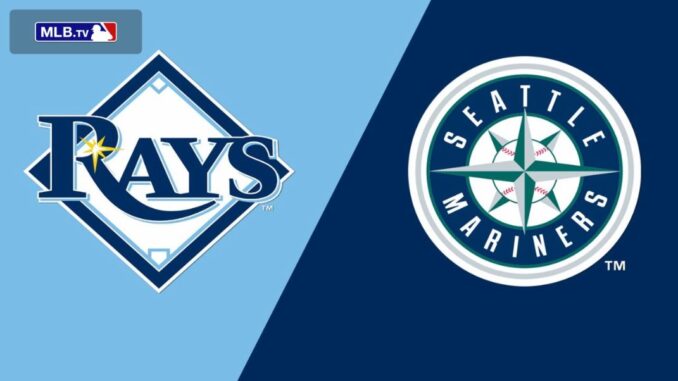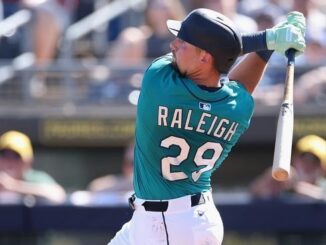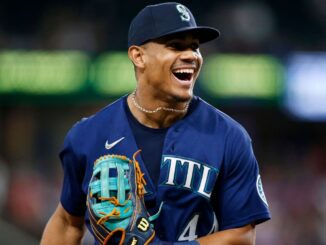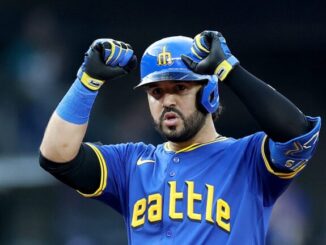
The Seattle Mariners are heading into the new year with an unchanged roster, marking one of their most uneventful offseasons yet. This lack of activity has left fans, this site’s staff, and local and national journalists scratching their heads.
With rumors scarce, this week we’ll explore several potential strategies to address Seattle’s offseason priorities and position the Mariners as front-runners in the American League West. We start today with a longstanding trade scenario involving Jerry Dipoto’s favorite trade partner—a move that could catapult Seattle into contention while staying within a budget even John Stanton would approve of.
The Trade
The Seattle Mariners trade RHP Matt Brash, OF Mitch Haniger, 1B Tyler Locklear, C Harry Ford, LHP Brandyn García, and $5 million to the Tampa Bay Rays in exchange for 1B/3B Yandy Díaz and 2B Brandon Lowe.
The Fit for Tampa Bay
Tampa Bay finds itself in an unusual position. Their typical strategy of staying competitive by cycling through arbitration-eligible players has been disrupted by Wander Franco’s unofficial ban from baseball, which could soon become official. Losing their star player has left the team adrift in one of the league’s toughest divisions. As a result, the Rays seem poised to take a slight step back this season. They’ve already traded Randy Arozarena to Seattle and recently offloaded Jeffrey Springs and his salary in a deal with the A’s.
The team’s top remaining hitters, Yandy Díaz and Brandon Lowe, are both under contract through 2026 (with club-friendly team options for that final year). They’re also the only position players over 30 on the Rays’ roster. If Tampa Bay doesn’t remain competitive into 2025, it would make sense for them to consider trading these players now or by this year’s trade deadline to maximize their value.
The Rays are reportedly taking a cautious approach, setting a high asking price for both players. For Díaz alone, they’re seeking at least two prospects and a major leaguer in return. This “we need to be blown away to move them” stance mirrors how the Mariners handled Luis Castillo, making such a deal expensive but realistic for a motivated team.

In this scenario, the Rays could acquire Matt Brash, one of the league’s top young relievers, under team control for up to four seasons. Tampa Bay has the luxury of being patient with Brash’s recovery from Tommy John surgery, as they don’t urgently need his immediate contributions. Once healthy, he could return as one of baseball’s premier relievers, either aiding their future competitive window or serving as a valuable trade chip.
Mitch Haniger would likely serve as a placeholder, competing with non-roster invitee Eloy Jimenez for a bench role or being moved elsewhere. Tyler Locklear, a player with significant analytical appeal, could slide into their 2025 lineup as part of the team’s next core. Luis García offers a nearly MLB-ready pitcher with strong potential, capable of developing into either a high-leverage reliever or a mid-rotation starter. Lastly, Harry Ford, a prospect reportedly coveted by the Rays, would address the organization’s glaring lack of standout catching talent, both now and in the future. This package could set the Rays up for long-term success while allowing them to reset.
The Fit for Seattle
This single move addresses an entire offseason’s worth of upgrades. Yandy Díaz and Brandon Lowe instantly strengthen the heart of Seattle’s lineup. The most appealing aspect for the Mariners: the two would only add $20.5M to their 2025 payroll ($10M for Díaz and $10.5M for Lowe). If Seattle can offload most of Mitch Haniger’s contract, the net payroll increase drops to just $10M — a bargain for two starting-caliber players. It’s a deal hard to replicate elsewhere this winter.
The trade package going to Tampa would be tough for Seattle to part with, but it keeps the rotation intact and preserves all of their top five prospects.
Díaz is a perfect fit for Jerry Dipoto’s style. With a career 130 wRC+, powered by excellent plate discipline (8.1% BB rate and 15.3% K-rate in 2024) and gap-to-gap power, his bat should thrive at T-Mobile Park. Defensively, Díaz is primarily a first baseman and not a particularly good one. In this scenario, he would take over as the Mariners’ everyday DH, their best since Nelson Cruz. He could also occasionally cover first base against lefties to give Luke Raley a break, but using him at third base regularly would be a stretch.
Lowe, on the other hand, brings similarities to Jorge Polanco — a 30-year-old second baseman with average contact skills, above-average power, and an injury-prone history. However, Lowe has more power than Polanco and a stronger track record overall. His injuries have been varied but his recurring back issues make a fully healthy season unlikely. Still, Lowe has played at least 100 games in three of the last four seasons and remains a 120 wRC+ hitter when healthy. Across his seven big league seasons, Lowe has never posted a wRC+ below 100. Defensively, he’s average in range but has a below-average arm. Importantly, this trade allows Seattle to keep Cole Young, who could step in when Lowe inevitably misses time.
With Díaz and Lowe on board, the Mariners’ projected Opening Day lineup could look like this:
- RF Victor Robles
- CF Julio Rodríguez
- DH Yandy Díaz
- C Cal Raleigh
- LF Randy Arozarena
- 2B Brandon Lowe
- 1B Luke Raley
- SS J.P. Crawford
- 3B Dylan Moore
This lineup positions the Mariners as clear division favorites on paper. It significantly bolsters their offense, retains their elite rotation, and preserves critical infield depth for roster flexibility. Both Díaz and Lowe also come with club options for 2026 ($12M and $11.5M, respectively), giving Seattle cost-effective control for another season.
Although trading one of their premier relievers would be painful, Seattle has consistently proven adept at finding low-cost bullpen solutions — far more so than manufacturing bats. By making this deal, the Mariners would solidify themselves as the team to beat in the AL West, fielding a lineup that matches the strength of their rotation. It’s a gamble that moves the needle and justifies the cost.



Be the first to comment